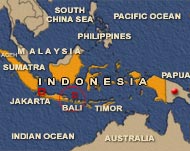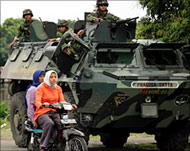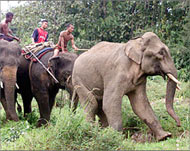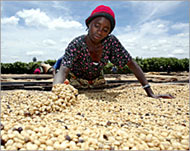Guess where this coffee comes from?
How much would you pay for a cup of liquid cat dung? Quite a lot, if some highly discerning coffee drinkers are anything to go by.

On the lush, volcanic slopes of the Indonesian archipelago, villagers “harvest” kopi luwak.
The beans used for the world’s rarest and most expensive coffee have already been munched by cat-like palm civets, and now they are plucked from the dung to be dried and roasted.
Retailing in North America and Europe for up to $600 a kg, kopi luwak, literally “civet coffee” in Indonesian, is not a brew for the faint hearted.
Less than 230kg of it is estimated to be produced a year on the islands of Java, Sumatra and Sulawesi, and war and disease are making it even harder to find.
“I first read about it in 1980 but didn’t manage to get my
hands on any until 1993,” says Michael Beech of Raven’s Brew
Coffee Inc.
Until last year, when supplies began to dry up, it
was the main supplier of kopi luwak in the United States.
 |
|
The kopi luwak bean comes from |
His clients have ranged from ordinary java junkies to comedy actor John Cleese of Monty Python fame, he says.
The firm has a backlog of 300 kopi luwak orders to fill at $75 for 114 grams.
“To be honest, you can’t get $75 worth of quality in any coffee. You are really paying for the experience,” says Beech.
Fussy eater
The brew has become so rare that a newly published book on
coffee in Indonesia, “A cup of Java,” relegates it to legend.
“We have failed to find any coffee-seller who admits to
actually selling kopi luwak from the faeces of the civet cat,”
write authors Gabriella Teggia and Mark Hanusz.
To many Indonesians, the term kopi luwak has come to mean
simply the beans which the civet – a notoriously fussy eater
which selects only the ripest coffee cherries – would choose.
 |
|
The war in Aceh province made |
“We just use the name for branding, but we don’t trade in it,” says Jeffrey Susanto, whose family runs the Kopi Luwak string of gourmet coffee shops in Jakarta.
The rarity of kopi luwak is confirmed by Nugroho Bintang Satrio, the Central Java chief of the Indonesian Coffee
Exporters Association.
“Only a tiny portion of small-holders are left who collect it,” he said, adding that traders buy it at about 11,000 rupiah ($1.30) a kilo, about twice the price of ordinary robusta.
Deadly harvest
In the last year, a government offensive against rebels in
rugged Aceh province on the northern tip of Sumatra has also
cut into supply. “Farmers get killed if they harvest the coffee
too far into the bush,” said one trader.
Then there is the bad press caused by the deadly flu-like
SARS virus.
Civets, which are not cats but are related to mongooses, have been slaughtered in their thousands in China and imports banned from many Western countries for fear they carry SARS.
“Even if SARS was associated with the coffee itself, by the
time it’s collected and washed there is a very long period that
has elapsed,” says Massimo Marcone, a food scientist at the
University of Guelph in Canada, who has carried out extensive
tests on kopi luwak and deemed it safe.
 |
|
Producers are working on an |
Yet, despite all that, some still harbour doubts.
“Sumatra, in the popular imagination anyway, is just too close to China and I’m just wary of the whole SARS thing,” says Beech, adding that Raven’s Brew may cease to offer kopi luwak.
“We are working on an elephant poop coffee,” he says with a chuckle, explaining a plan he vows is serious.
The idea is to feed coffee to tuskers at an elephant orphanage in Sri Lanka and sell the product, farming the proceeds back into the orphanage.
“It will be a do-gooder coffee, pooped out by bonafide orphan elephants,” Beech explains.
According to some experts, a bean that has been partly digested tastes special.
“What I did find with kopi luwak was that the acids, the gastric juices and the enzymes were actually getting inside the bean and breaking down the proteins,” says Marcone.
“You start getting amino acids. When these things are heated during roasting, they react with other components and they create certain flavour compounds different from other beans.”
Exotic processing
So what does the world’s most pricey coffee taste like?
 |
|
Pure unadulterated coffee beans, |
Coffee buffs say it depends on whether the civet has been
eating arabica or robusta beans.
“Initially people thought it must be the best coffee in the world, but I have to be honest about it, it’s a crappy cup of
coffee,” says Beech of the robusta variety.
No matter how exotic the processing, it is mostly robusta cherries the luwak munches.
That fact is a legacy of the coffee blight which in 1878 destroyed every low-lying arabica plant from Ceylon to Timor, allowing Brazil and Colombia to take the lead as the world’s main suppliers of arabica.
Weeks of phone calls around Indonesia results in a fragrant mailbox containing a brown envelope from an East Java coffee
trader. Inside is 250 grams of brown gold – kopi luwak arabica.
The aroma is rich and strong and the beans oily. Ground and
steeped in boiling water the flavour is, well, much like any
other coffee.
But the experience lingers in the memory.